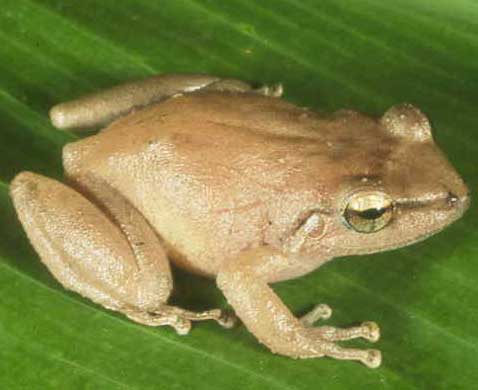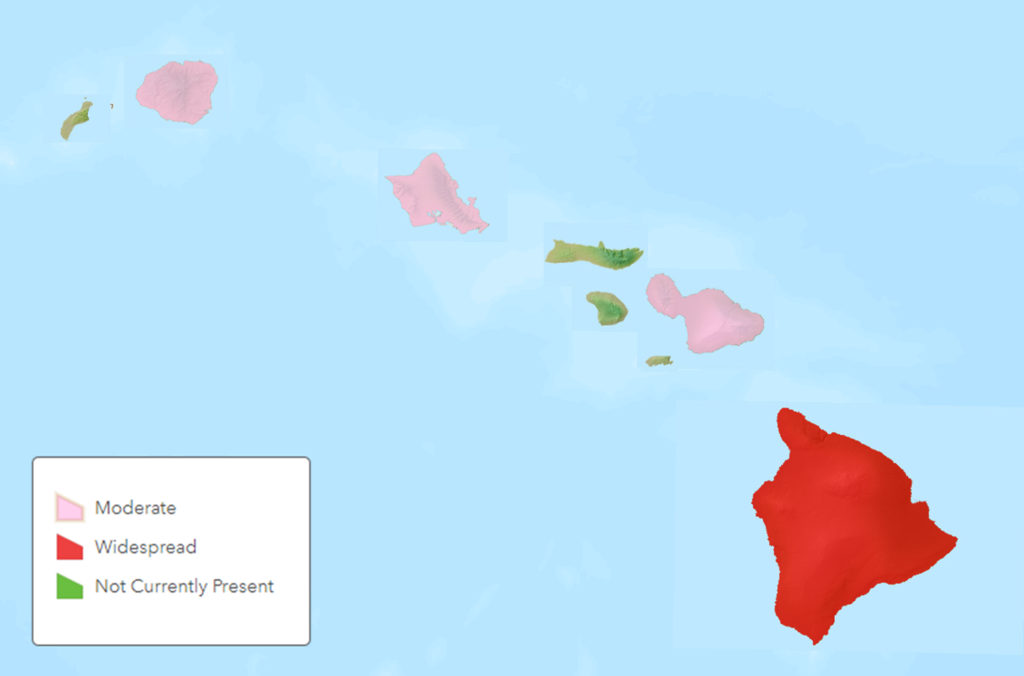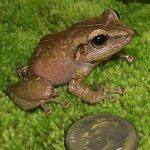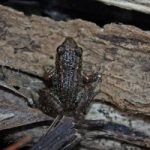Coqui frog
Eleutherodactylus coqui

- Regulatory Status: Hawai’i Injurious Wildlife (Exhibit 5, Chapter 13-124)
- What You Can Do: Report on Oʻahu, Maui, Molokai, Lānaʻi, and Kauaʻi by submitting a report through 643pest.org or call 808-643-7378 (643-PEST). Control this species on your property if you are on Hawaiʻi Island. Make your yard un-friendly to frogs.
- Prevention and Control Category: OISC target species. KISC target species. MISC target species. MoMisc target species.

Photo credit above: DLNR
- Scaled photo of coqui frog with a dime
- Scaled photo of coqui frog with a penny
- Greenhouse frog, common look-alike to coqui frog
Photo credit above from left tor right: DLNR, Wikipedia: Cathybwl, DLNR

DESCRIPTION:
- The coqui is a small, nocturnal, 1-2 inch tree frog with colors varying from tan to dark brown.
- It has a round body shape and a broad rounded snout with distinctive toe pads.
- They make a distinctive co-qui, (pronounced “ko-kee”) vocalization that is rather loud. (Can reach up to 95 decibels)
- They are found on ground level and in trees and bushes, but their calls are primarily made from 1-2m (3-7 feet) high.
- “Native to Puerto Rico, accidentally introduced to Hawaiʻi hidden in plants around or before 1988.” (MIISC)
- “Lays egg clusters in moist damp areas, males sit on eggs.” (BIISC)
- There is a common look alike called the greenhouse frog. See the differences here.
IMPACTS:
- Hawaiian populations reach densities of up to 91,000 frogs/hectare (Beard et al., 2009), two to three times higher than estimates for native populations in Puerto Rico (Woolbright et al., 2006), and among the highest known for any amphibian worldwide.
-
Eat huge quantities of insects, removing insects from forest floor to treetops. This results in the loss of insect services, such as pollination.
-
Disrupts the balance of vulnerable native ecosystems and has been known to change the chemical composition of the forest floor. (KISC)
- Produces loud, incessant and annoying call from dusk until dawn. (Up to 95 dB – similar to a motorcycle engine) Hear a recording of a single frog progressing into multiple frogs
-
Potential food source for snakes if they were to arrive.
-
Disclosure requirement for real estate transactions, has resulted in decreased property values in some locations.
-
“Presence of coqui hinders export of plant sales.” (KISC)
-
Adverse economic impacts on tourism.
ERADICATION & CONTROL METHODS:
- Create traps that take advantage of the frogs nesting behavior by hanging PVC pipe. (Instructions on how to make trap)
- “Citric acid is the only product labeled for controlling coqui in Hawaii. Frogs breathe through their skin so they are highly sensitive to chemical contact. Spray solution on infested plants to kill coqui frog eggs, juveniles, and adults. Treatments can be repeated every 2 weeks.” (BIISC)
- You can make your landscaping less coqui-friendly by cutting tall grass, not keeping bromeliads, chipping or eliminating green waste, removing dead leaves from banana, ti, and other plants with large leaves, and thinning understory vegetation on your property.
- You can hand catch frogs. “Once captured in the bag, frogs can be killed humanely by placing them in hot soapy water or in the freezer.” (CTAHR)
WHAT YOU CAN DO:
- If you see this species on Maui, O’ahu, Kaua’i, Molokai, or Lānaʻi, call 643-PEST and/or visit 643pest.org to report it!
- Control coqui frogs on your property if you live in an infested area.
- Eliminate frog friendly habitat in your yard.
- Learn to identify coqui frogs visually and audially.
For more information
- Coqui Frog – Oʻahu Invasive Species Committee (OISC)
- Coqui Frog – Big Island Invasive Species Committee (BIISC) (Trap/lure instructions and citric acid mixing instructions)
- Coqui Frog – Maui Invasive Species Committee (MISC)
- Coqui Frog – Kauaʻi Invasive Species Committee (KISC)
- Controlling Coqui Frogs
- Coqui Frog Control for Homeowners: CTAHR – UH Manoa
- Make Your Yard Un-Friendly to Coqui Frogs – MISC
- Greenhouse frog Vs. Coqui Frog from CTAHR


